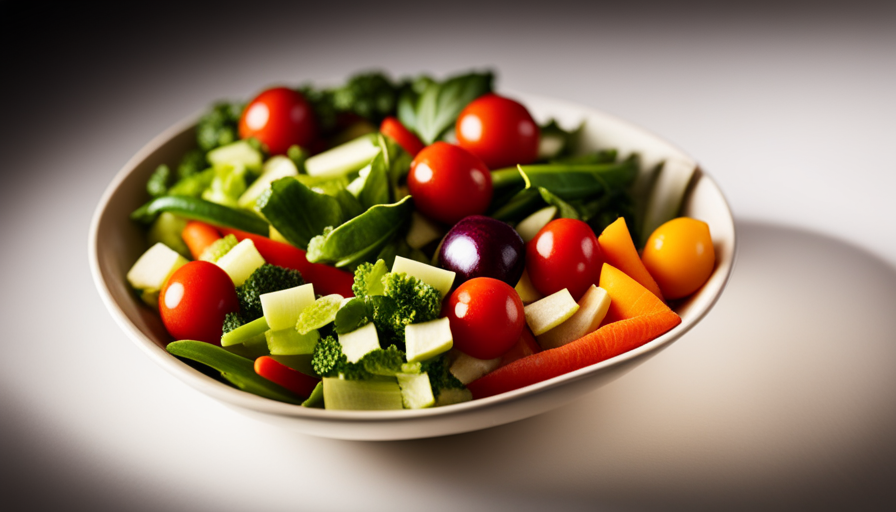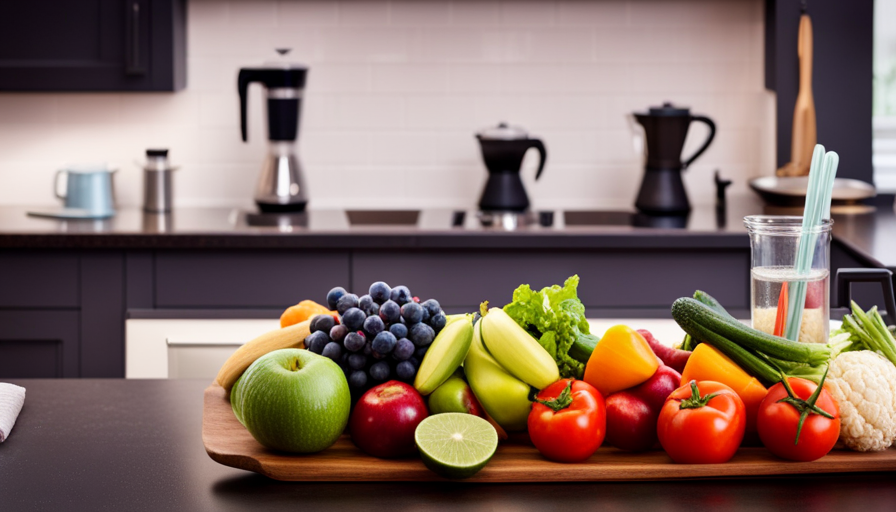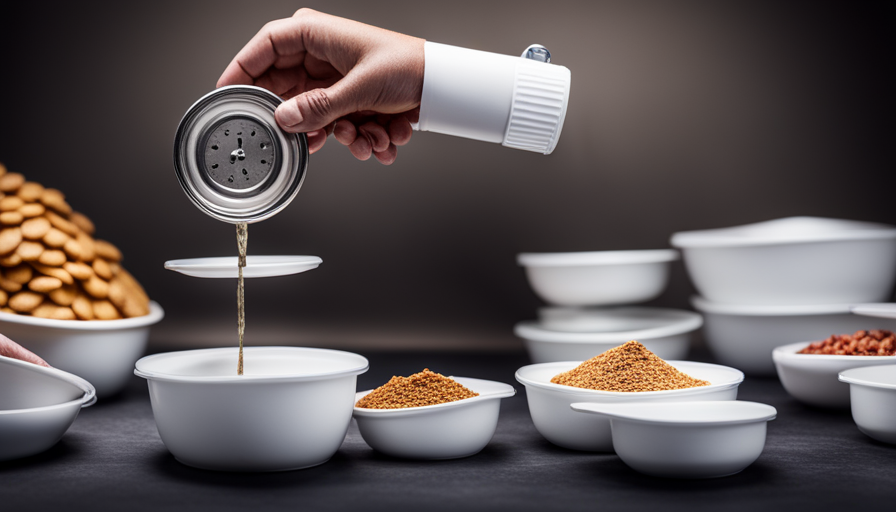Are you tired of using the same old traditional ingredients to boost the flavor of your raw food dishes?
Well, it’s time to add a burst of taste and excitement to your meals with coconut aminos! Like a ray of sunshine on a cloudy day, coconut aminos can bring a whole new level of flavor to your raw food creations.
Made from the sap of coconut blossoms, this healthy alternative to soy sauce is not only delicious, but also packed with essential amino acids, vitamins, and minerals.
In this article, we will explore the various ways you can incorporate coconut aminos into your raw food recipes.
From enhancing the flavor of dressings and marinades, to creating zesty Asian-inspired salads and raw sushi rolls, the possibilities are endless.
So, grab your apron and get ready to take your raw food dishes to a whole new level of deliciousness with coconut aminos!
Key Takeaways
- Coconut aminos is a versatile ingredient that can be used in a variety of raw food recipes.
- It can be used to enhance the flavor of dressings, marinades, salads, and raw sushi rolls.
- Coconut aminos can be combined with other ingredients like garlic, ginger, honey, or citrus juices to create flavorful marinades.
- It adds a burst of mouthwatering flavor to dishes when used in stir-frying.
Coconut Aminos: A Healthy Alternative to Soy Sauce
Coconut aminos is a healthy alternative to soy sauce, making it the perfect choice for those looking to reduce their sodium intake. It not only provides a similar flavor profile to soy sauce but also offers a range of benefits that make it a standout ingredient in the world of raw food.
One of the key benefits of coconut aminos is its lower sodium content. While soy sauce can be high in sodium and contribute to bloating and water retention, coconut aminos contains about 73% less sodium. This makes it a great option for individuals who are watching their salt intake or following a low-sodium diet.
In addition to being low in sodium, coconut aminos also contains essential amino acids, vitamins, and minerals. This natural sauce is made from the sap of coconut blossoms, which is then aged and blended with sea salt. The result is a rich and flavorful sauce that adds depth to any raw food dish.
When using coconut aminos in raw food recipes, there are a few cooking tips to keep in mind. First, it’s important to note that coconut aminos has a slightly sweeter taste compared to soy sauce. This sweetness can enhance the flavors of fruits and vegetables in raw food dishes. Additionally, coconut aminos pairs well with other ingredients commonly used in raw food, such as ginger, garlic, and lemon juice.
Coconut aminos is a great choice for those looking to incorporate a healthier alternative to soy sauce in their raw food recipes. With its lower sodium content and array of benefits, it’s a versatile ingredient that can add flavor and depth to a variety of dishes.
Enhancing Flavor in Raw Food Recipes
To add a burst of flavor to your plant-based meals, try incorporating coconut aminos as a soy sauce alternative. For instance, imagine a vibrant salad bursting with fresh vegetables, drizzled with a tangy and savory dressing made with coconut aminos, garlic, and lemon juice. Not only does this enhance the taste of your raw food recipes, but it also provides you with a healthier option compared to traditional soy sauce.
Coconut aminos can be used in a variety of ways to enhance the flavor of your dishes. One creative idea is to incorporate them into flavorful smoothies. By adding a splash of coconut aminos to your favorite smoothie recipe, you can create a unique and delicious flavor profile. Additionally, coconut aminos can be used as a base for creative salad dressings. Mix it with other ingredients like olive oil, apple cider vinegar, and herbs to create a tangy and delicious dressing that will elevate your salads to a whole new level.
In order to help you understand the versatility of coconut aminos in enhancing the flavor of your raw food recipes, take a look at the table below:
| Dish | Coconut Aminos Pairing |
|---|---|
| Stir-fried vegetables | Coconut aminos add a savory umami flavor to the dish. |
| Raw spring rolls | A dipping sauce made with coconut aminos adds a tangy kick. |
| Raw sushi rolls | Coconut aminos can be used as a soy sauce substitute for dipping. |
| Marinated tofu | Coconut aminos can be used in the marinade for a flavorful twist. |
| Zucchini noodles | Tossing zoodles with coconut aminos adds a deliciously savory taste. |
By experimenting with coconut aminos in your raw food recipes, you can create flavorful and nutritious dishes that will satisfy your taste buds and support your healthy lifestyle.
Creating Delicious Dressings with Coconut Aminos
Imagine drizzling a tangy and savory dressing made with garlic, lemon juice, and a soy sauce alternative over a vibrant salad bursting with fresh vegetables, enhancing the flavor and adding a delicious twist. Creating delicious dressings with coconut aminos is a fantastic way to elevate your raw food recipes.
Coconut aminos, a popular soy sauce alternative made from the sap of coconut blossoms, offers a unique and flavorful addition to your dressings.
To create a mouthwatering dressing, start by combining coconut aminos with minced garlic, freshly squeezed lemon juice, and a touch of olive oil. This combination adds a tangy and savory flavor that complements a variety of raw vegetables. You can also experiment with adding other ingredients like ginger, honey, or herbs to create your own unique marinades.
Coconut aminos can also be used in raw dips to add depth and complexity to your flavors. Mix coconut aminos with avocado, lime juice, and cilantro for a creamy and tangy dip that pairs perfectly with vegetable sticks or raw crackers. Alternatively, blend coconut aminos with soaked cashews, garlic, and nutritional yeast to create a cheesy and flavorful dip.
By incorporating coconut aminos into your raw food recipes, you can create delicious dressings and dips that’ll impress your taste buds. Experiment with different combinations and enjoy the unique flavors that coconut aminos bring to your dishes.
Marinating with Coconut Aminos for Maximum Flavor
Enhance the flavor of your dishes by marinating with this flavorful soy sauce alternative, allowing the coconut aminos to infuse your ingredients with maximum taste.
Marinating is a fantastic way to add depth and complexity to your dishes, and coconut aminos are the perfect ingredient to achieve that.
When it comes to marinade ideas, the possibilities are endless. You can use coconut aminos as a base and add other ingredients like garlic, ginger, honey, or citrus juices to create a marinade that suits your taste preferences. For a savory twist, try combining coconut aminos with sesame oil and a touch of mirin for a delicious Asian-inspired marinade.
To maximize the flavor infusion, make sure to marinate your ingredients for an adequate amount of time. For meats, overnight marinating is ideal, as it allows the flavors to penetrate deeply. For vegetables or tofu, marinating for at least 30 minutes will do the trick.
Another flavor enhancing technique is to reserve some of the marinade and use it as a basting sauce while cooking. This’ll help to intensify the flavors and create a beautiful glaze on your grilled or roasted dishes.
Marinating with coconut aminos is a fantastic way to enhance the flavor of your dishes. With a wide range of marinade ideas and flavor enhancing techniques, you can take your culinary creations to the next level. So go ahead, experiment with different combinations and let the coconut aminos work their magic!
Stir-Frying with Coconut Aminos: A Burst of Taste
Get ready to experience a burst of mouthwatering flavor when you stir-fry your favorite ingredients with the irresistibly delicious coconut aminos! Not only does coconut aminos add a unique taste to your stir-fry dishes, but it also brings numerous health benefits to the table.
When using coconut aminos in marinades, it acts as a natural tenderizer, making your meats and vegetables more tender and juicy. The rich umami flavor enhances the taste of your ingredients, creating a delightful fusion of flavors that will leave your taste buds craving for more.
But the wonders of coconut aminos don’t stop there. You can also blend it into smoothies to add a savory twist to your drinks. The mild sweetness of coconut aminos complements the fruity flavors in smoothies, giving them a depth and complexity that is truly satisfying. Plus, coconut aminos are a great alternative to soy sauce for those who are gluten-free or have soy allergies.
Incorporating coconut aminos into your stir-fry dishes and smoothies is not only a delicious choice but also a healthy one. Coconut aminos are low in sodium, contain essential amino acids, and are rich in vitamins and minerals.
So, go ahead and explore the versatility of coconut aminos in your kitchen, and elevate your stir-fries and smoothies to a whole new level of taste and nutrition.
Dipping Sauces Made Easy with Coconut Aminos
Discover the secret to effortlessly creating flavorful dipping sauces with the help of the versatile and health-conscious coconut aminos. Whether you’re looking to add some Asian-inspired flair to your traditional recipes or exploring the world of vegan cooking, coconut aminos can be your go-to ingredient for enhancing the taste of your sauces.
Coconut aminos, derived from the sap of coconut blossoms, brings a unique and savory flavor to your dipping sauces. Its umami-rich taste adds depth and complexity without overpowering other ingredients. Plus, it’s a fantastic alternative to soy sauce for those with soy allergies or following a gluten-free diet.
Here are three reasons why coconut aminos should be a staple in your sauce-making repertoire:
- Health-conscious choice: Coconut aminos are low in sodium and contain essential amino acids, making them a healthier option compared to traditional soy sauce.
- Versatility: From tangy teriyaki to zesty sweet and sour, coconut aminos can be used as a base for various dipping sauces, allowing you to experiment and create unique flavors.
- Vegan-friendly: Coconut aminos are plant-based and free from animal products, making them ideal for vegan cooking. They provide a similar umami taste without compromising your dietary preferences.
So, the next time you’re preparing a dipping sauce, don’t forget to reach for the bottle of coconut aminos. Your taste buds and health will thank you!
Incorporating Coconut Aminos into Raw Sushi Rolls
Try adding a burst of flavor to your sushi rolls by incorporating the versatile and health-conscious coconut aminos. Not only do raw sushi recipes provide a refreshing and nutritious meal option, but when you use coconut aminos as a dipping sauce or marinade, you elevate the overall taste experience.
Coconut aminos are a popular substitute for soy sauce, as they’re gluten-free, low in sodium, and packed with beneficial nutrients. Made from the sap of coconut blossoms, this condiment is rich in amino acids, vitamins, and minerals. It also contains natural enzymes that aid digestion and boost immune function.
To incorporate coconut aminos into your raw sushi rolls, start by using them as a dipping sauce for your rolls. The slightly sweet and savory flavor of coconut aminos complements the freshness of the raw ingredients, adding depth and complexity. You can also use coconut aminos as a marinade for the vegetables or fish you include in your rolls. Marinating them for a short time in coconut aminos will infuse them with a delightful umami taste.
By using coconut aminos in your raw sushi recipes, you not only enhance the flavor but also reap the health benefits. So, give it a try and elevate your sushi rolls to a new level of taste and nutrition.
Using Coconut Aminos in Zesty Asian-Inspired Salads
Are you craving a zesty Asian-inspired salad that’ll take your taste buds on a flavorful journey? Look no further than incorporating coconut aminos into your summer slaws and raw noodle dishes.
Coconut aminos, a delicious soy sauce alternative made from the sap of coconut blossoms, adds a unique depth of flavor and umami to any dish.
When making a zesty Asian-inspired salad, start by mixing together shredded cabbage, carrots, bell peppers, and cucumber. To create the dressing, whisk together coconut aminos, sesame oil, rice vinegar, and a touch of honey for a perfect balance of sweet and tangy. Toss the dressing with the vegetables, and top with some toasted sesame seeds and chopped scallions for added crunch and freshness.
If you’re looking to incorporate coconut aminos into raw noodle dishes, try making a refreshing and light zucchini noodle salad. Spiralize zucchini into noodles and combine with thinly sliced bell peppers, julienned carrots, and chopped cilantro. For the dressing, mix together coconut aminos, lime juice, garlic, and a pinch of red pepper flakes for a spicy kick. Toss the noodles with the dressing and let the flavors meld together.
By using coconut aminos in your zesty Asian-inspired salads and raw noodle dishes, you can elevate your meals with a burst of flavor that’ll transport your taste buds to the heart of Asia. So go ahead, get creative, and enjoy the deliciousness of coconut aminos in your summer creations.
Adding Depth to Raw Soups and Broths with Coconut Aminos
Adding a few drops of coconut aminos to your raw soups and broths is like adding a secret ingredient that unlocks a world of savory flavor. It not only adds depth and complexity to your dishes, but it also enhances the umami taste, making each spoonful a delightful experience.
Coconut aminos, with its rich and earthy flavor, is the perfect addition to raw soups and broths. It brings a unique salty-sweet taste that complements the fresh ingredients beautifully. Whether you’re making a refreshing gazpacho or a comforting miso soup, a splash of coconut aminos will take your creation to the next level.
Raw marinades can often lack the depth of flavor that comes from cooking. But with coconut aminos, you can easily overcome this challenge. Its rich amino acid content adds a savory note to your marinades, making them more robust and flavorful. Simply combine coconut aminos with other raw ingredients like garlic, ginger, and citrus juices for a delicious and nutritious marinade.
Not only does coconut aminos add flavor, but it also offers health benefits. It’s gluten-free, low in sodium, and packed with essential amino acids, vitamins, and minerals. So, you can enjoy the taste while nourishing your body.
Adding coconut aminos to your raw soups and broths is a simple yet effective way to elevate your dishes. It brings umami flavor to your creations and enhances the overall taste. So, go ahead and experiment with this versatile ingredient in your raw food recipes for a delicious and nutritious experience.
Sweet and Savory Raw Desserts with Coconut Aminos
Indulge in the decadent world of sweet and savory raw desserts that come alive with a touch of magic from the rich and earthy essence of coconut aminos. This versatile ingredient adds a unique depth of flavor to your raw desserts, taking them to a whole new level of deliciousness.
Here are five exciting ways to incorporate coconut aminos into your raw dessert creations:
-
Raw Food Smoothies: Blend coconut aminos with fresh fruits, such as bananas or berries, to create a luscious and creamy smoothie that’ll leave your taste buds craving more. The subtle sweetness of the coconut aminos perfectly balances the tartness of the fruits.
-
Raw Vegan Burgers: Use coconut aminos as a key ingredient in your raw vegan burger patties. It adds a savory umami taste that enhances the overall flavor of the burger. Simply mix it with mashed beans, vegetables, and spices, and shape the mixture into patties for a satisfying and protein-packed meal.
-
Raw Chocolate Truffles: Create irresistible raw chocolate truffles by combining coconut aminos with raw cacao powder, dates, and nuts. The coconut aminos add a hint of caramel-like flavor that pairs perfectly with the rich chocolatey taste.
-
Raw Cheesecake: Incorporate coconut aminos into the crust or filling of your raw cheesecake for a subtle savory note that complements the creamy texture. It adds a touch of complexity to the classic dessert.
-
Raw Caramel Sauce: Whip up a delicious raw caramel sauce by blending coconut aminos with dates, almond butter, and a pinch of sea salt. Drizzle it over your raw desserts for a decadent and indulgent treat.
With these creative ideas, you can elevate your raw desserts to new heights by harnessing the incredible flavor of coconut aminos. Enjoy the sweet and savory delights that this magical ingredient brings to your raw food creations.
Frequently Asked Questions
Can coconut aminos be used as a substitute for soy sauce in cooked dishes?
Yes, coconut aminos can be a great substitute for soy sauce in cooked dishes. They’re made from the sap of coconut blossoms, so they’re gluten-free, soy-free, and have a lower sodium content. They have a similar salty and umami flavor to soy sauce. If you’re looking for a homemade alternative, you can make coconut aminos by fermenting coconut sap with salt, water, and vinegar.
Are there any health benefits to using coconut aminos instead of soy sauce?
There are indeed health benefits to using coconut aminos instead of soy sauce. Coconut aminos are naturally gluten-free, soy-free, and contain significantly less sodium than soy sauce. They also provide essential amino acids, vitamins, and minerals. Studies have shown that coconut aminos may have antioxidant and anti-inflammatory properties.
Additionally, coconut aminos have a lower glycemic index compared to soy sauce, making it a better option for those watching their blood sugar levels.
Can coconut aminos be used in baking or other heated recipes?
Yes, you can definitely use coconut aminos in baking or other heated recipes. Coconut aminos are commonly used as a substitute for soy sauce. They can also be used in marinades to add a rich, savory flavor to your dishes. Additionally, incorporating coconut aminos into salad dressings can provide a unique and delicious twist. So go ahead and experiment with coconut aminos in your favorite heated recipes, and enjoy the health benefits it offers as well.
How long does a bottle of coconut aminos typically last once opened?
Once opened, a bottle of coconut aminos typically lasts for around 6 to 12 months. Proper storage is important to ensure its shelf life. Keep the bottle tightly sealed and store it in a cool, dry place away from direct sunlight. Refrigeration isn’t necessary, but it can help extend the shelf life. Regularly check for any signs of spoilage, such as a change in color, odor, or taste, before using.
Are there any specific types of raw food recipes that coconut aminos work best in?
Incorporating coconut aminos in raw food recipes is like adding a burst of flavor to a blank canvas. This versatile condiment can elevate your raw dishes to a whole new level. It pairs well with various ingredients like zucchini noodles, raw sushi rolls, or even a fresh salad.
Get creative and experiment with unique ways to incorporate coconut aminos in raw dishes, and you’ll discover a world of delicious possibilities.
Can Coconut Aminos Be Used as a Substitute for Soy Sauce in a Raw Food Diet?
Yes, coconut aminos can be used as a substitute for soy sauce in a raw food diet. It is a great option for those following a raw or eating quinoa raw diet, as it is made from the sap of coconut blossoms and is a natural, gluten-free alternative to soy sauce.
Conclusion
Congratulations! You’ve now unlocked the secret to unleashing the full potential of your raw food recipes with the incredible power of coconut aminos. By incorporating this healthy alternative to soy sauce, your taste buds will dance with delight as you take your dishes to new heights.
From enhancing flavors and creating mouthwatering dressings to marinating for maximum flavor and adding a burst of taste to stir-fries, coconut aminos is your ticket to culinary success.
So go ahead, dive into the world of zesty salads, savory soups, and sweet desserts with the magic of coconut aminos. Your taste buds will thank you!










